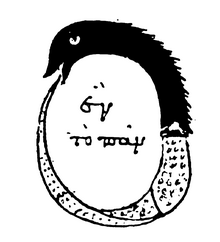The ouroboros (/ˌjʊərəˈbɒrəs/; /ʊəˈrɒbərəs/; Greek: οὐροβόρος) is an ancient symbol depicting a serpent or dragon eating its own tail. Originating in Ancient Egyptian iconography, the ouroboros entered western tradition via Greek magical tradition and was adopted as a symbol in Gnosticism and Hermeticism, and most notably in alchemy. Via medieval alchemical tradition, the symbol entered Renaissance magic and modern symbolism, often taken to symbolize introspection, the eternal return or cyclicality, especially in the sense of something constantly re-creating itself. It also represents the infinite cycle of nature's endless creation and destruction, life and death.
Historical representations
Ancient Egypt
The first known appearance of the ouroboros motif is in the Enigmatic Book of the Netherworld, an ancient Egyptian funerary text in KV62, the tomb of Tutankhamun, in the 14th century BC. The text concerns the actions of the god Ra and his union with Osiris in the underworld. In an illustration from this text, two serpents, holding their tails in their mouths, coil around the head, neck, and feet of an enormous god, who may represent the unified Ra-Osiris. Both serpents are manifestations of the deity Mehen, who in other funerary texts protects Ra in his underworld journey. The whole divine figure represents the beginning and the end of time.
The ouroboros appears elsewhere in Egyptian sources, where, like many Egyptian serpent deities, it represents the formless disorder that surrounds the orderly world and is involved in that world's periodic renewal. The symbol persisted in Egypt into Roman times, when it frequently appeared on magical talismans, sometimes in combination with other magical emblems. The 4th-century AD Latin commentator Servius was aware of the Egyptian use of the symbol, noting that the image of a snake biting its tail represents the cyclical nature of the year.
Classical Antiquity
In Plato's Timaeus, the character Timaeus describes the self-sufficiency and perfection of the created cosmos, which can be compared to the ouroboros.
The Timaeus describes the perfection of the created world and the status of all living beings, which participate in creation and embody some different aspect of the Good, with each being individually contributing to the universe's overall perfection and essential completeness.
Alchemy and Gnosticism
The famous ouroboros drawing from the early alchemical text The Chrysopoeia of Cleopatra (Greek: Η χρυσοποιία της Κλεοπάτρας) probably dating to third century Alexandria encloses the words hén tó pãn (Greek: ἕν τό πᾶν), "one is the all". Its black and white halves represent the Gnostic duality of existence. As such, the ouroboros could be interpreted as the Western equivalent of the Taoist yin and yangsymbol. The chrysopoeia ouroboros of Cleopatra the Alchemist is one of the oldest images of the ouroboros to be linked with the legendary opus of the alchemists, the philosopher's stone.
As a symbol of the eternal unity of all things, the cycle of birth and death from which the alchemist sought release and liberation, it was familiar to the alchemist and physician Sir Thomas Browne. In his A Letter to a Friend, a medical treatise full of case-histories and witty speculations upon the human condition, he wrote of it:
In Gnosticism, a serpent biting its tail symbolized eternity and the soul of the world. The Gnostic Pistis Sophia (c. 400 AD) describes the ouroboros as a twelve-part dragon surrounding the world with his tail in his mouth.
The "world serpent" in mythology
In Norse mythology, the ouroboros appears as the serpent Jörmungandr, one of the three children of Loki and Angrboda, which grew so large that it could encircle the world and grasp its tail in its teeth. In the legends of Ragnar Lodbrok, such as Ragnarssona þáttr, the Geatish king Herraud gives a small lindworm as a gift to his daughter Þóra Town-Hart after which it grows into a large serpent which encircles the girl's bower and bites itself in the tail. The serpent is slain by Ragnar Lodbrok who marries Þóra. Ragnar later has a son with another woman named Kráka and this son is born with the image of a white snake in one eye. This snake encircled the iris and bit itself in the tail, and the son was named Sigurd Snake-in-the-Eye.
It is a common belief among indigenous people of the tropical lowlands of South America that waters at the edge of the world-disc are encircled by a snake, often an anaconda, biting its own tail.
Connection to Indian thought
Ouroboros symbolism has been used to describe the Kundalini energy. According to the medieval Yoga-kundalini Upanishad, "The divine power, Kundalini, shines like the stem of a young lotus; like a snake, coiled round upon herself she holds her tail in her mouth and lies resting half asleep as the base of the body" (1.82).
Storl (2004) also refers to the ouroboros image in reference to the "cycle of samsara".






No comments:
Post a Comment
The power is in knowing that you are the center of the universe